This post contains affiliate links, which means I may earn a commission if you purchase through those links (at no extra cost to you).
Homemade Ancho Chile Powder is easy and inexpensive when you make it at home, and it’s just one ingredient. Add it to salsas, salad dressings, and marinades for a smoky, spicy heat.
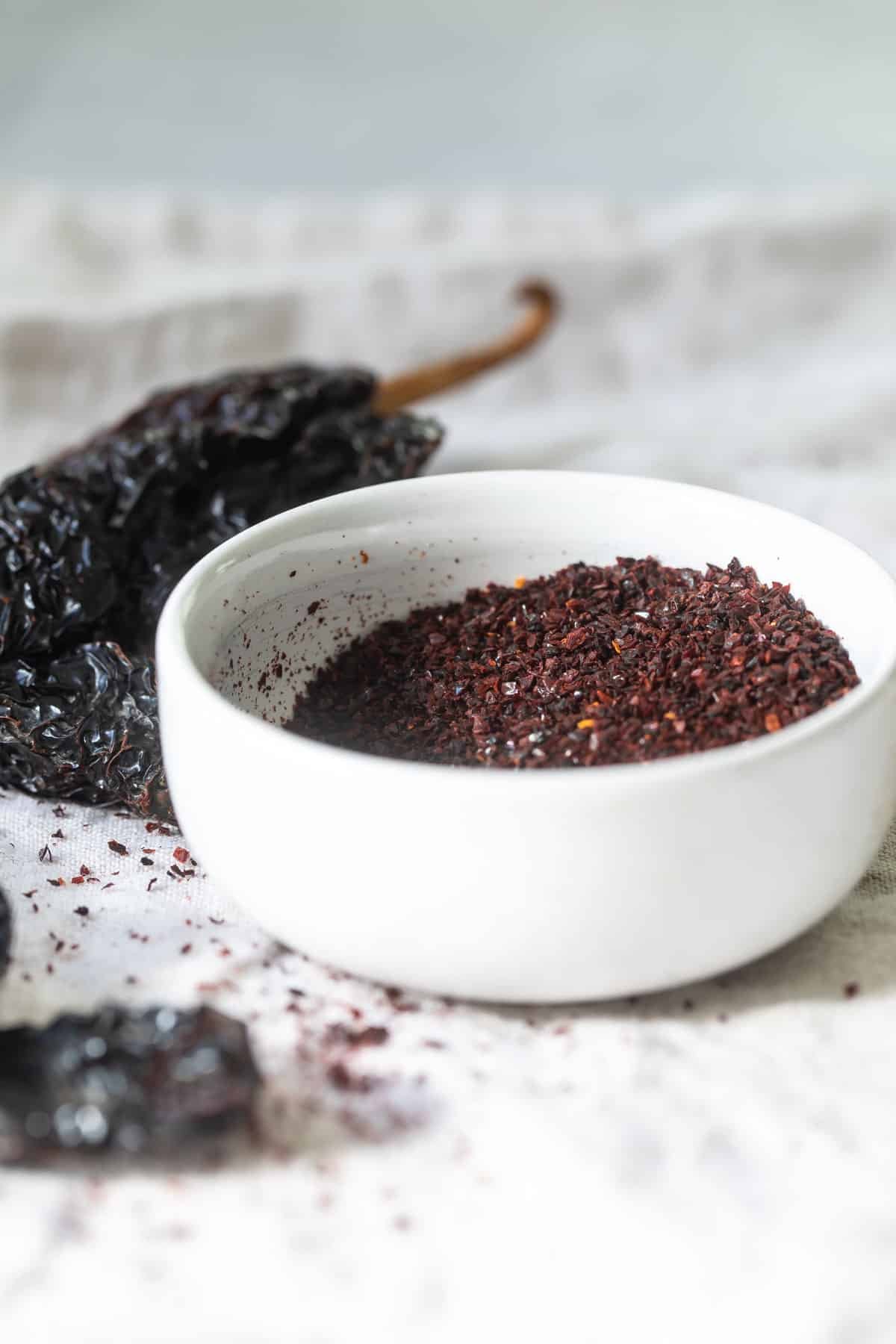
The Ancho chile pepper is a ripened, dried poblano or pasilla pepper. At the store, a fresh poblano pepper is green because it is harvested before it is ripened. If left to ripen, they turn red. Ripened, red poblanos are then dried to make ancho chiles. These chiles are extremely popular in Mexico. They are used in salsas by soaking them first and then blending them in a blender, or you can grind them to make Ancho Chile Powder.
In certain parts of the United States, dried ancho chiles are widely available. In others, you never see them. However, you can usually locate Ancho Chile Powder.
The problem with Ancho Chile Powder is not its versatility nor its robust flavor. It’s the COST. It’s usually several dollars for a jar, or even more, and I’m guessing you only shell out that kind of money for saffron. And probably not even for saffron.
So the punchline of all this is, homemade Ancho Chile Powder is SO EASY to make, and dirt cheap. So let’s get right to it.
Table of Contents
Recipe ingredients
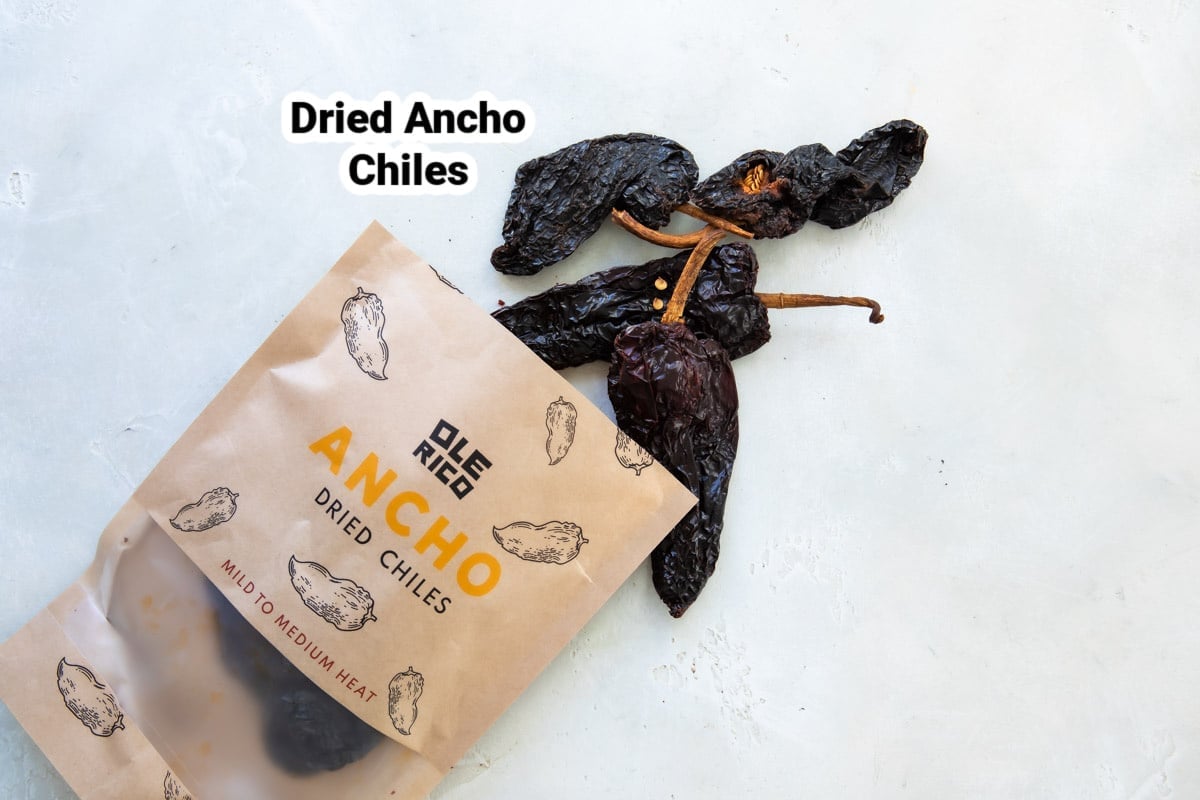
At a Glance: Here is a quick snapshot of what ingredients are in this recipe.
Please see the recipe card below for specific quantities.
Ingredient notes
- Ancho chiles: Ancho chiles ripened, dried poblano peppers. At the store, fresh poblanos are green because they are harvested before they are ripened. If left to ripen, they turn red. Ripened, red poblanos are then dried to make ancho chiles. They have a smoky flavor that is common in Southwestern cuisine and authentic Mexican cooking. Their flavor is mild (1,000 – 2,000 Scoville heat units). Their pod skins are wrinkly and look a little bit like giant raisins with a stem.

What should I use to grind ancho chiles?
I like to use an electric spice grinder, but a small food processor or a high-quality blender should also be able to handle the job. The KRUPS Fast Touch Electric Grinder is my favorite one because it’s powerful and easy to clean. You can get it at Walmart for $19.98 but I recommend a few others in my best spice grinder roundup!
Step-by-step instructions
- Open the chile peppers by pulling them apart with your hands or cutting with a knife (wearing gloves is recommended). Carefully pull out and discard the stem. Shake or scrape out all seeds. Repeat with remaining chilies.
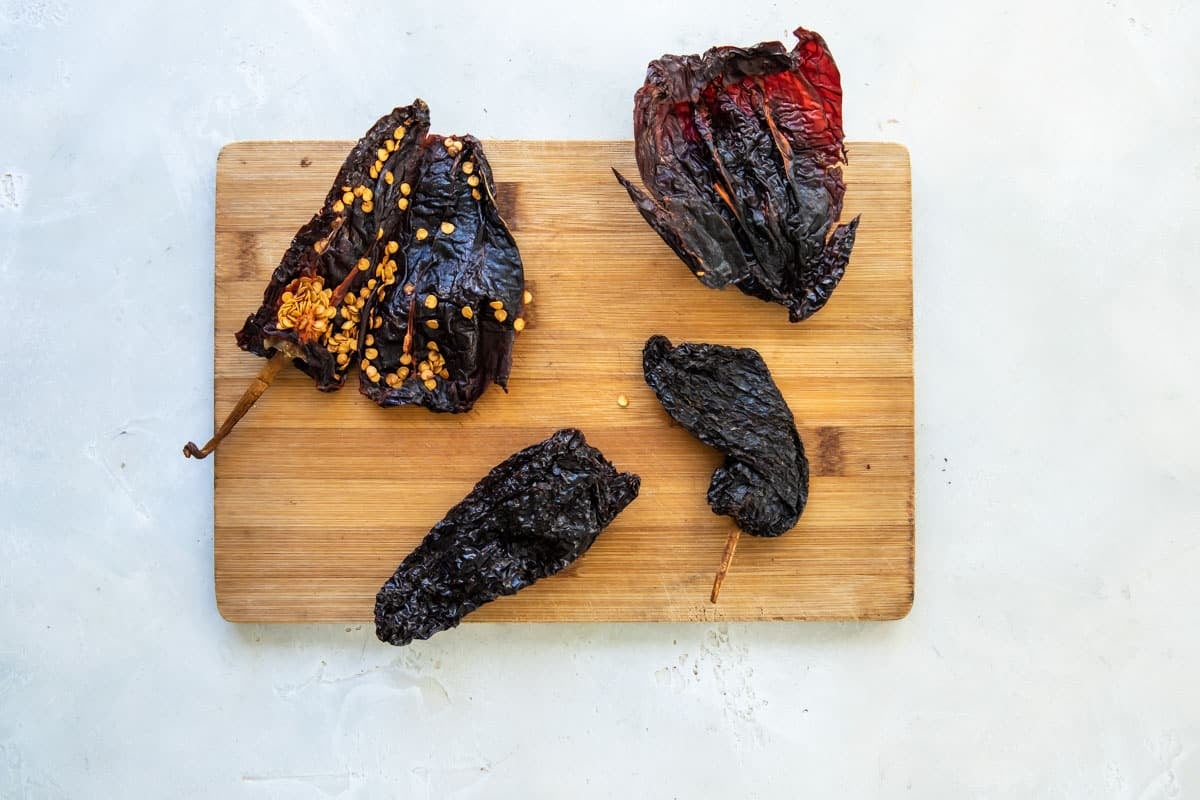
- Tear cleaned chile pieces into 1” or 2” pieces. Place in an electric grinder or small food processor.
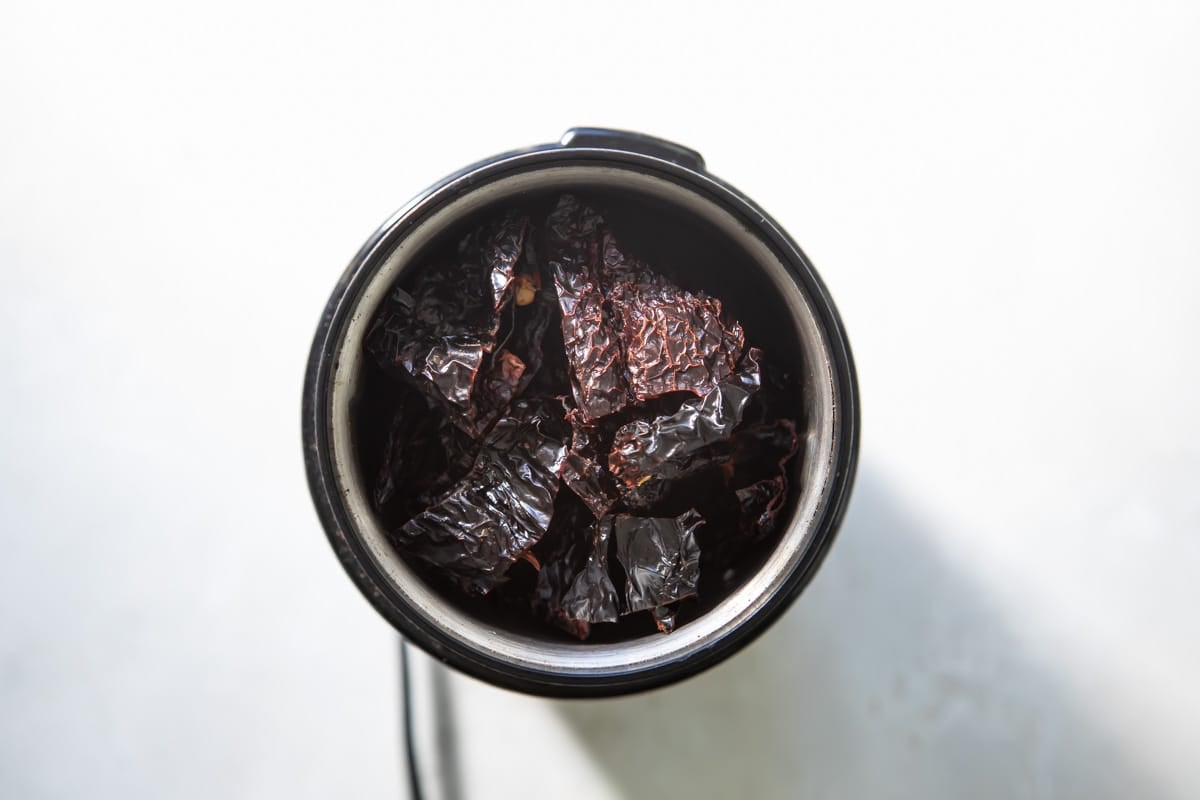
- Process in batches until finely ground.
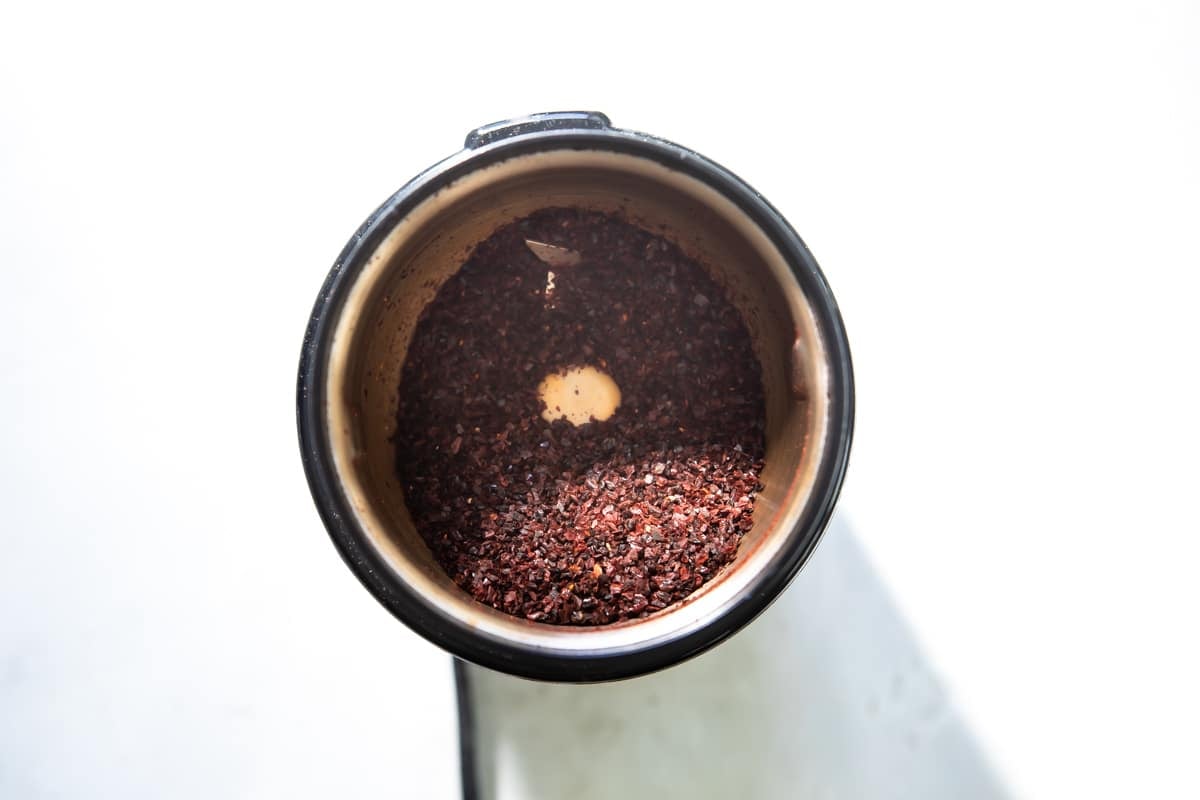
- Store covered in an airtight container.

Recipe tips and variations
- Yield: One (2-ounce) package dried chiles will contain 2 to 4 dried chiles, depending on their size, and will yield about ¼ cup ancho chile powder.
- Storage: Store Ancho Chile Powder in a cool, dark place for up to 6 months (or longer, but the potency decreases after 6 months) in a spice jar or other airtight container.
- Chili: Use Ancho Chile Powder in your next batch of Homemade Chili Seasoning or add directly to soups like Beef Chili, Venison Chili, Turkey Chili, Hot Dog Chili, or Chili Con Carne. Or, sprinkle on vegetables or potatoes with Mexican oregano before roasting.
- Chipotle Copycat Recipes: Ancho chili powder is a cornerstone ingredient in Chipotle Chicken, Chipotle Barbacoa, Chipotle Steak, and Chipotle Sofritas.
- Mole Poblano: This thick and savory mole sauce is made with chile peppers, chocolate, tomatoes, and cinnamon, and it comes from the state of Puebla in Mexico. In fact, it is often considered Mexico’s national dish. Ancho chile powder is a key ingredient. Mole poblano is excellent served over Mexican rice and with crisp, fresh lettuce leaves to cut the richness of the mole.

Frequently Asked Questions
They are the same thing; it’s really just a matter of naming conventions. “Chile” is the Spanish word for capsicums such as jalapeños, serranos, habañeros, poblanos, and so on. Americans sometimes spell it “chili” but now we are moving towards “chile” because “chili” is the stew with the meat.
We sometimes say “pepper” in the United States because when Columbus arrived, he thought chiles were “peppers” (as in spicy black pepper, a member of the Piper genus). He was wrong. We always use the word “pepper” for non-spicy peppers such as bell peppers.
Chili powder is a blend made from various ground spices including, but not limited to, ground chiles, garlic powder, onion powder, paprika, and/or cayenne pepper. Ancho chile powder is just one specific chile, dried poblanos, that have been ground up. It is slightly spicier than regular chili powder.
Note: If you shop at an international food market and buy “chili powder,” sometimes this is just straight-up ground dried red chiles (cayenne pepper), not the Americanized chili powder blend you’re thinking of. You should be able to tell by the color of the powder.
You can substitute regular chili powder plus a small amount of crushed red pepper for heat.
1 teaspoon ancho chile powder = 1 teaspoon regular chili powder + ⅛ to ¼ teaspoon crushed red pepper
Ancho dried chiles are always in stock at my local International foods markets and Mexican grocery stores. Sometimes I find them at regular groceries stores too or even Walmart. They usually sell for around $2 or less for a 2-ounce package. You can also buy them online, although I understand that spending $8 on dried ancho chiles isn’t much better than spending $6 on a bag of Ancho Chile Powder. Even if it’s a good value, it’s still a lot of money. So, try to find them locally.
Put your ancho chile powder to work
Chipotle Copycat Recipes
Chipotle Chicken (Copycat)
Chipotle Copycat Recipes
Chipotle Steak (Copycat)
Chipotle Copycat Recipes
Copycat Chipotle Barbacoa
Chipotle Copycat Recipes
Chipotle Sofritas (Copycat)
Join Us

Homemade Ancho Chile Powder
Ingredients
- 2 ounces dried Ancho Chiles (see note 1)
Instructions
- Open the chile peppers by pulling them apart with your hands or cutting with a knife (wearing gloves is recommended). Carefully pull out and discard the stem. Shake or scrape out all seeds. Repeat with remaining chilies.
- Tear cleaned chile pieces into 1” or 2” pieces. Place in an electric grinder or small food processor and process in batches until finely ground. Store covered in an airtight container.
Notes
- Ancho chiles: Ancho chiles ripened, dried poblano peppers. At the store, fresh poblanos are green because they are harvested before they are ripened. If left to ripen, they turn red. Ripened, red poblanos are then dried to make ancho chiles. They have a smoky flavor that is common in Mexican and Southwestern cooking. Their flavor is mild (1,000 – 2,000 Scoville heat units). Their skins are wrinkly and look a little bit like giant raisins with a stem.
- Yield: One (2-oz.) package dried chiles will contain 2 to 4 dried chiles, depending on their size, and will yield about ¼ c. ancho chile powder.
- Storage: Store Ancho Chile Powder in a cool, dark place for up to 6 months (or longer, but the potency decreases after 6 months).

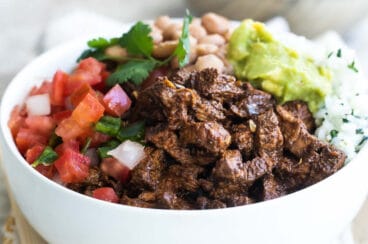


If you like low & slow barbeque beef ribs, my go-to bbq expert, Meathead, has a killer rub for beef ribs which uses Ancho chile. He says “I’m looking for complexity with two different flavors and two different levels of heat. Most American chili powders and ancho powders do not have a lot of heat, but good flavor. In fact, ancho is usually in a lot of American chili powders. Go with ancho if you can find it. It has a nice raisiny character. With chipotle or cayenne I’m after a kiss of heat. Chipotle has better flavor though.” His rub recipe is at http://amazingribs.com/recipes/rubs_pastes_marinades_and_brines/big_bad_beef_rub.html. I’m smoking my ribs right now.
In the near future I’ll be creating one of my monthly posters featuring “the ampersand as fun & fabulous art” entitled “Low & Slow” for bbq fans and ampersand fans. But one poster that I created a few months ago is for “Hot & Spicy” fans: http://amperart.com/91-hot-spicy/ See the tail of the ampersand?
Thanks for your tasty site, Meggan.
Hey Chaz! Thanks for the great comment. A recipe recommendation AND tasty art in one, it’s my lucky day! Your Hot & Spicy piece is pretty sweet. Well done. Thanks for the best comment ever, I appreciate it! I’m looking forward to seeing your Low & Slow poster when it’s ready. Take care!
Thanks for the fast reply. I looked on the web site….WOW!!!! What a great site. I’ll be using that for sure, some good products there.
Thanks Meggan X
Hi Meggan. I live in Australia so which peppers could I use to make this???? Love the recipes. X
Hi Pauline! I am not sure if this is actually helpful, but I found this Australian Mexican Food store: http://www.montereyfoods.com.au/home.php They sell dried ancho chile peppers. If not this grocery store, perhaps there is another Mexican grocery store that you know of? I could suggest other dried chiles, but truly if you want to make ancho chile powder it has to be made with dried ancho chiles. For obvious reasons. 🙂 Good luck! If I find out anything more I’ll be sure to let you know.
No worries. Thank you so much for your prompt response. : )
Is it necessary to wear gloves?
No, it is absolutely not necessary to wear gloves. I’m kind of obsessed with wearing latex gloves in my kitchen because I have small children, and if I have to attend to them suddenly, I don’t want to hurt them with some random piece of spicy food. It’s easier to just rip off the gloves. But no. I am going to go back and revisit this post and make sure the wording is clearer about that. Sorry for the confusion!
Wear gloves. The oil gets in your skin and afterwards, if you touch your eyes, man of man, it will burn!
I am definitely going to try this. Does a regular grocery store sell dried ancho chile peppers or will I need to go to a specially store?
Hi Tricia, it’s hit & miss for me. Sometimes regular grocery stores have them, or maybe they sell other dried chiles but not anchos. Walmart has them sometimes too but not always. If I absolutely need them and can only make one stop, I go to my local international food market. So that would probably be a “specialty” store. I do know that when I find them, they are always cheap (under $2). So I tend to stock up and keep some packages in the freezer. Good luck!
Can you use a food processor if you do not have a grinder?
Hi Emily, if you can get a find grind, then yes you can. I haven’t tried it, but I am definitely willing to do so and report back. It’s certainly worth a try!
Thanks for this good practical advice! It’s easy to find the whole dried ones and the ground stuff is hard to find and expensive.
Thank you, Jennifer! I agree, the jarred ancho chile pepper is way more expensive compared to the peppers. It’s crazy! Glad you found this to be useful! 🙂
Really nice post, Meggan! Very informative (as usual) and it’s a nice touch to include the recipes from other bloggers. I’ll take a look!
Great way to get fresh seasonings and not spend a lot of money. Spices are expensive! Does this smell really spicy when you grind it up or just fragrant?
nope. not very spicy at all